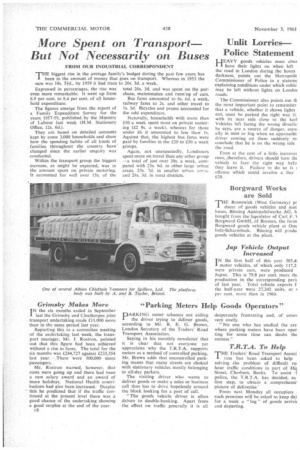More Spent on Transport—
Page 44

If you've noticed an error in this article please click here to report it so we can fix it.
But Not Necessarily on Bases
FROM OUR INDUSTRIAL CORRESPONDENT
THE biggest rise in the average family's budget during the past few years has been in the amount of money that goes on transport. Whereas in 1953 the sum was 16s. 5-Id., by 1959 it had risen to 26s. 3d. a week.
Expressed in percentages, the rise was even more remarkable. It went up from 6.9 per cent. to 8.4 per cent, of all household expenditure.
The figures emerge from the report of a Family Expenditure Survey for the years 1957-59, published.by the Ministry of Labour last week (11.M. Stationery Office, 12s. 6d.).
They are based on detailed accounts kept by some 3,000 households and show how the spending habits of all kinds of families throughout the country have changed since the earlier enquiry was conducted.
Within the transport group the biggest increase, as might be expected, was in the amount spent on private motoring. It accounted for well over I5s. of the total 26s. 3d. and was spent on the purchase, maintenance and rundng of ears.
Bus fares amounted to .6s. 6d. a week, railway fares to 2s. and other travel to Is. 3d. Bicycles and prams accounted for the odd expenditure.
Naturally, households with inure than £50 a week spent most on private motoring (£2 9s. a week), whereas for those under £6 it amounted to less than Is. Against that, the highest bus fares were paid by families in the £20 to.f50 a week gimps.
Again, not unexpectedly, Londoners spent more on travel than any other group —a total of just over 30s. a week, cornpared with 23s. 6d. in other large urban areas, 25s. 7d. in smaller urban areas. and 28s. 3d. in rural districts.
























































































































